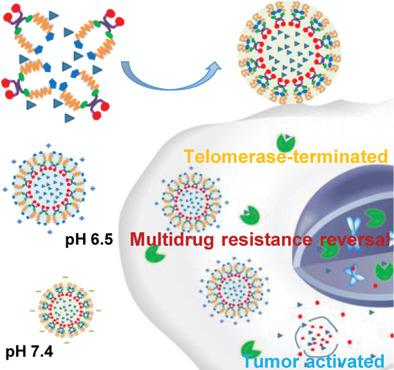当前位置:
X-MOL 学术
›
Adv. Healthcare Mater.
›
论文详情
Our official English website, www.x-mol.net, welcomes your
feedback! (Note: you will need to create a separate account there.)
Tumor-Oriented Telomerase-Terminated Nanoplatform as Versatile Strategy for Multidrug Resistance Reversal in Cancer Treatment.
Advanced Healthcare Materials ( IF 10.0 ) Pub Date : 2020-03-03 , DOI: 10.1002/adhm.201901739 Yahui Wu 1, 2 , Dan Zhong 1 , Yachao Li 1 , Huayu Wu 1 , Xianghui Xu 3 , Jun Yang 4 , Zhongwei Gu 1, 3
Advanced Healthcare Materials ( IF 10.0 ) Pub Date : 2020-03-03 , DOI: 10.1002/adhm.201901739 Yahui Wu 1, 2 , Dan Zhong 1 , Yachao Li 1 , Huayu Wu 1 , Xianghui Xu 3 , Jun Yang 4 , Zhongwei Gu 1, 3
Affiliation

|
Multidrug resistance is one of the major problems in chemotherapy, and exploiting impactful targets to reverse drug resistance of most tumors remains a difficult problem. In this study, the tumor-oriented nanoparticle, BIBR1532-loaded peptide dendrimeric prodrug nanoassembly (B-PDPN), is used to assist telomerase inhibition for multidrug resistance reversal. B-PDPN possesses the characteristics of an acid-activated histidine to promote cellular uptake, a redox-sensitive poly(ethylene glycol) (PEG) layer to actualize endosomal escape and telomerase inhibitor release, and an acid sensitive chemical bond to facilitate chemotherapeutic drug release. Telomerase termination weakens the protective effect of hTERT protein on mitochondria and enhances reactive oxygen species (ROS) production, which increases DNA damage and apoptosis. The tumor-oriented nanoparticle B-PDPN achieves a broad-spectrum telomerase inhibition to combat multidrug resistance. In vivo experiments support the evidence that B-PDPN accumulates in the tumor site and reduces the expression of hTERT in tumor tissues to inhibit drug resistant tumor growth. This work introduces an innovative strategy of utilizing features of tumor-activated nanoplatform to assist telomerase termination. The nanoplatform enhances intracellular drug concentration and nucleus delivery of doxorubicin (DOX), and promotes DNA damage to combat multidrug resistance.
中文翻译:

肿瘤导向端粒酶终止的纳米平台作为癌症治疗中多药耐药逆转的多功能策略。
多药耐药性是化学疗法中的主要问题之一,利用有影响的靶标逆转大多数肿瘤的耐药性仍然是一个难题。在这项研究中,肿瘤导向的纳米粒子,BIBR1532加载肽树状大分子前体药物纳米组装(B-PDPN),用于协助端粒酶抑制多药耐药性的逆转。B-PDPN具有以下特征:酸激活的组氨酸可促进细胞摄取;氧化还原敏感的聚乙二醇(PEG)层可实现内体逃逸和端粒酶抑制剂的释放;酸敏感的化学键可促进化疗药物的释放。端粒酶终止削弱了hTERT蛋白对线粒体的保护作用,并增强了活性氧(ROS)的产生,从而增加了DNA损伤和细胞凋亡。肿瘤导向的纳米粒子B-PDPN可实现广谱端粒酶抑制作用,以对抗多药耐药性。体内实验支持B-PDPN在肿瘤部位积聚并降低hTERT在肿瘤组织中的表达以抑制耐药性肿瘤生长的证据。这项工作介绍了利用肿瘤激活的纳米平台的特征来协助端粒酶终止的创新策略。纳米平台提高了阿霉素(DOX)的细胞内药物浓度和细胞核递送,并促进了DNA损伤以对抗多药耐药性。这项工作介绍了利用肿瘤激活的纳米平台的特征来协助端粒酶终止的创新策略。纳米平台提高了阿霉素(DOX)的细胞内药物浓度和细胞核递送,并促进了DNA损伤以对抗多药耐药性。这项工作介绍了利用肿瘤激活的纳米平台的特征来协助端粒酶终止的创新策略。纳米平台提高了阿霉素(DOX)的细胞内药物浓度和细胞核递送,并促进了DNA损伤以对抗多药耐药性。
更新日期:2020-04-08
中文翻译:

肿瘤导向端粒酶终止的纳米平台作为癌症治疗中多药耐药逆转的多功能策略。
多药耐药性是化学疗法中的主要问题之一,利用有影响的靶标逆转大多数肿瘤的耐药性仍然是一个难题。在这项研究中,肿瘤导向的纳米粒子,BIBR1532加载肽树状大分子前体药物纳米组装(B-PDPN),用于协助端粒酶抑制多药耐药性的逆转。B-PDPN具有以下特征:酸激活的组氨酸可促进细胞摄取;氧化还原敏感的聚乙二醇(PEG)层可实现内体逃逸和端粒酶抑制剂的释放;酸敏感的化学键可促进化疗药物的释放。端粒酶终止削弱了hTERT蛋白对线粒体的保护作用,并增强了活性氧(ROS)的产生,从而增加了DNA损伤和细胞凋亡。肿瘤导向的纳米粒子B-PDPN可实现广谱端粒酶抑制作用,以对抗多药耐药性。体内实验支持B-PDPN在肿瘤部位积聚并降低hTERT在肿瘤组织中的表达以抑制耐药性肿瘤生长的证据。这项工作介绍了利用肿瘤激活的纳米平台的特征来协助端粒酶终止的创新策略。纳米平台提高了阿霉素(DOX)的细胞内药物浓度和细胞核递送,并促进了DNA损伤以对抗多药耐药性。这项工作介绍了利用肿瘤激活的纳米平台的特征来协助端粒酶终止的创新策略。纳米平台提高了阿霉素(DOX)的细胞内药物浓度和细胞核递送,并促进了DNA损伤以对抗多药耐药性。这项工作介绍了利用肿瘤激活的纳米平台的特征来协助端粒酶终止的创新策略。纳米平台提高了阿霉素(DOX)的细胞内药物浓度和细胞核递送,并促进了DNA损伤以对抗多药耐药性。











































 京公网安备 11010802027423号
京公网安备 11010802027423号